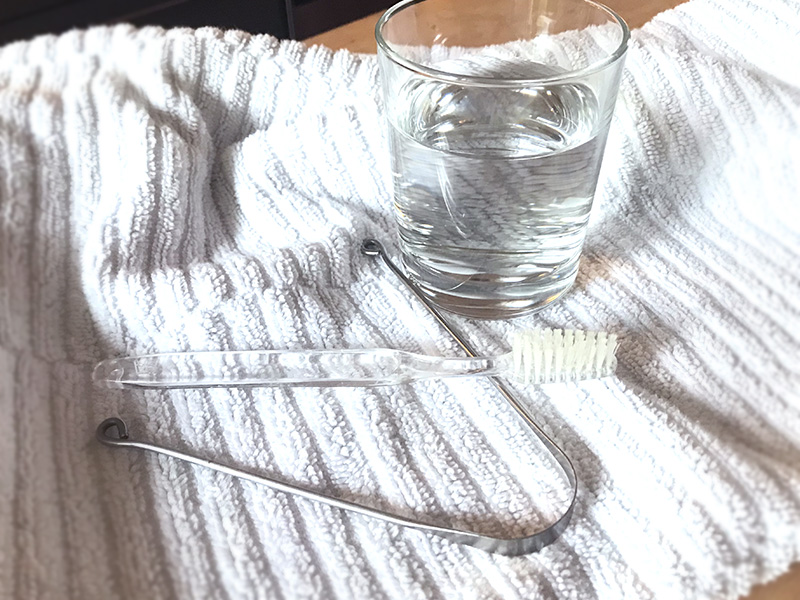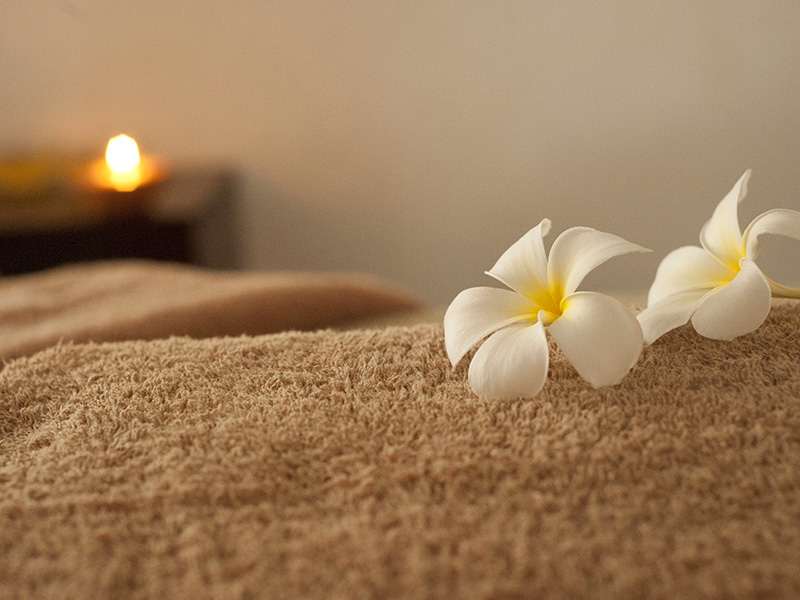Your perfect start to the day
Your Ayurvedic morning routine to cleanse your sensory organs
- PART I -
"Like oil in sesame, like butter in milk, like water in underground springs, like fire in the rubbing sticks - so the one who seeks it with truthfulness and practice, experiences the SELF hidden in the everyday self."
Svetasvatara Upanisad
If you want to live healthier, happier and longer, Ayurveda will help you stay healthy and happy.
Here are a few useful tips to get your day off to the best possible start - these recommendations are suitable for everyone, regardless of constitution, age or gender.
What is Dinacharya?
Dinacharya refers to the Ayurvedic daily routine for a healthy and happy life and prevention of all diseases:
- Maintains stable and lasting immunity and resilience, brings balance and harmony to your body and mind,- contributes to an active metabolism and effective digestion, improves self-esteem,- brings the perceived state of happiness and promotes longevity.
the ayurvedic cleansing of the sensory organs
We perceive the world through our five senses. Everything we know, we have heard, seen, tasted, smelled or felt. It is therefore particularly important to take care of our senses so that we don't only half hear or see something distorted. Ayurveda shows you simple ways to take care of your senses and thus strengthen your perception.

Dinancharya
The perfect Ayurvedic start to a cleansed day:
1. after the mindful awakening...- Awakening in the time of Brahma Muhutra- thought detox- emptying of bowel and bladder...you will receive simple practices and valuable instructions one after the other to cleanse your sensory organs:2. your oral cavity:- Jiva Sodhana: Scrape your tongue- Gandusha: Fill your oral cavity with water- Kavala: Draw oil- Brush your teeth with herbal toothpaste3. your nose:- Jal Neeti: Your nasal shower- Nastarpana: Nasal drops with oil
...and in the next blog post coming soon:4. your eyes- Kahjal- cleansing the mucous membrane of the eye - Rose water- cooling the eye5. your skin- Abhyanga: small self-massage with Ayurvedic oils - or for Kapha excess:- Garshana: the silk glove massage or even for the hard-boiled Kapha constitutions the performance with a brush.6. hot water in the morningStart your day by drinking a large glass of warm water (I have summarized the benefits of this in my detailed blog from 16.9.2019 )
I am pleased to inform you that I have expanded my offer and now offer a free Ayurveda online course on my new online academy:
The course gives you easy-to-understand step-by-step instructions on how to apply the methods from this blog post in practice. I have created videos for you for each of the 8 days in which I explain the exact process.
YOU CAN STILL REGISTER HERE UNTIL THE START OF THE COURSE:
The course starts on 22.02.2020 at 6:00 am:
Sleep & Awakening
Awaken to the time of Brahma Muhurta
The Vata Dosha predominates between 5-6 am. This is considered the "golden time". A time that is just for you and still unencumbered. I often hear that - contrary to all expectations - most people find it particularly easy to get out of bed at this time.
Ayurveda recommends regular awakening in the early morning hours (1.5 hours before sunrise). This time is considered the sacred time and is also called Brahma Muhutra.
As we are subject to strong fluctuations in sunrise and sunset times in our latitudes, the time around 5 a.m. is a rough rule.
If you are particularly stressed at the moment and have to cope with great demands or during an illness, you should stay in bed a little longer in the morning. Children, pregnant women and elderly people also need more rest and can sleep a little longer.

Kapha people should wake up by 4.00 a.m.
Pitta people should wake up by 5.00 a.m.
Vata people should wake up by 5.30 in the morning
Gratitude for the day ahead
Meditate for 1 to 2 minutes immediately after waking up.
Actively develop the feeling of happiness, calmness and kindness in your mind and start the day with a smile. This little mindfulness exercise is very easy and very effective for a stress-free life and improves your memory and intelligence as well as your mental and analytical skills.
Your morning mindset has an impact on your entire day. So, meditation, thought focus and mindfulness after waking up will help you to have positive energy and make your day more constructive and joyful.
Do a mind detox
Our thoughts influence our mood. "Toxic" thoughts rob us of strength and energy, which is why it is beneficial for your well-being if you also do a mental detox. As a first mental detox exercise, try to dedicate the time in the morning entirely to yourself and avoid looking at your phone as soon as you get up to check social media or read the news before you are even properly awake. Spend the first hour of the day without your smartphone.
Allow yourself this time consciously for yourself. After getting up, stretch out in all directions and then breathe in and out deeply through your nose a few times with your eyes closed. Now open your eyes slowly and concentrate on what you perceive:
How does your body feel? What do you hear and see around you? Can you feel your breath?
When thoughts come, simply notice them without interpreting them. Something like this: "Aha, I'm thinking about whether I've really prepared everything for this afternoon's meeting. I'll take care of that in the office." Then focus on the moment again. This little mindfulness exercise helps you to be fully in the now. This conscious start to the day gives you strength for all the tasks and challenges that await you.
If you want to train your mindfulness in a more advanced way, sit upright in a favorite place on the floor or on a cushion and meditatively observe your breath. This exercise will only take you 5-15 minutes of your day and will help you to focus and concentrate for the whole day.
Do a mind detox
Our thoughts influence our mood. "Toxic" thoughts rob us of strength and energy, which is why it is beneficial for your well-being if you also do a mental detox. As a first mental detox exercise, try to dedicate the time in the morning entirely to yourself and avoid looking at your phone as soon as you get up to check social media or read the news before you are even properly awake. Spend the first hour of the day without your smartphone.
Allow yourself this time consciously for yourself. After getting up, stretch out in all directions and then breathe in and out deeply through your nose a few times with your eyes closed. Now open your eyes slowly and concentrate on what you perceive:
How does your body feel? What do you hear and see around you? Can you feel your breath?
When thoughts come, simply notice them without interpreting them. Something like this: "Aha, I'm thinking about whether I've really prepared everything for this afternoon's meeting. I'll take care of that in the office." Then focus on the moment again. This little mindfulness exercise helps you to be fully in the now. This conscious start to the day gives you strength for all the tasks and challenges that await you.
If you want to train your mindfulness in a more advanced way, sit upright in a favorite place on the floor or on a cushion and meditatively observe your breath. This exercise will only take you 5-15 minutes of your day and will help you to focus and concentrate for the whole day.
Bowel and bladder emptying
Ideally, you should feel the urge to empty your bladder and bowels as soon as you wake up. If food was eaten too late or inappropriately the day before, the urge may not arise until much later. Massage your bowels clockwise and drink plenty of hot water or ginger water to ignite your digestive fire (Agni). Kapha people should definitely be a little physically active in the morning so that the urge to empty the bowels arises.
Important: the urge to defecate must never be suppressed, otherwise metabolic toxins (ama) can build up. Take a shower (even if only a short one) after a bowel movement.


Tongue & teeth brushing
Ayurvedic oral hygiene for a better taste
"Deposits on the tongue impair breath and are the cause of bad breath. The tongue should therefore also be cleaned regularly." Charaka Samhita
Tongue scraping
Excess plaque should be removed from the tongue in the morning. A secretion forms on the tongue during the night. This secretion provides information about the digestibility of the last meals. If the last meal was not suitable for the dosha or was difficult to digest, we usually have a thick, white mucus on the tongue the next day, which can hardly be removed even after removing it 2-3 times. This coating will also be more noticeable during colds.
In Ayurveda we regard this mucus as Ama - the metabolic toxin, which we should avoid swallowing if possible, in order to support the body in its tendency to cleanse itself.
It is therefore essential that you gently scrape off the coating on your tongue with a tongue scraper. If the tongue is coated, this can lead to the development of microorganisms, bad breath and a restricted or foul taste.
Use a special tongue scraper, preferably made of stainless steel (from a health food store)
- Place the tongue scraper as far back as possible at the base of the tongue without touching the uvula.
- Pull the coating forward towards the tip of the tongue 2-4 times with gentle pressure
- Clean the tongue scraper well under hot running water.
I can only recommend this simple deep clean to everyone: The entire mouth feels fresh and clean, the sense of taste is intensified and bad breath is significantly reduced. Personally, I can no longer go on vacation without my tongue scraper!

Tooth powder for gentle cleaning of your teeth and gums
Instead of the usual toothpaste, Ayurveda also uses powder to deep clean the teeth and gums. This is usually quite unusual for us, especially because we are no longer used to putting our hands in our mouths and on our teeth. Try it out. You'll get a good feel for your mouth and get to know your sensitive areas well and can treat them much better.
Instead of using store-bought mixtures, which usually contain sugar, you can make your own mixture to clean your teeth.
Recipe for your tooth powder:
Triphala powder Tanner acaciaLiquorice root, ground Arjuna bark powder Cassia cinnamon Cardamom ground Cloves ground Trikatu powder Rock salt
25 grams25 grams20 grams15 grams15 grams15 grams15 grams5 grams5 grams5 grams
The use of tooth powder:
- Take a small amount of tooth powder in the palm of your hand
- Add a little water to make a paste
- Now gently massage your teeth and gums with your fingers in small circles for 3 - 5 minutes
- Then gargle with warm water and rinse your mouth
Kavala - Oil pulling
After tongue scraping, you can now optimize your oral hygiene by performing oil pulling.
This application is somewhat strange at first, as we are not used to it in our culture. Nevertheless, the effect of this procedure can hardly be overestimated:
It can prevent periodontal disease, inflammation of the entire oral cavity and even the sinuses, and improves the sense of taste and smell.

According to ancient Ayurvedic scriptures, gandusha is said to improve the voice and protect against cracked lips, tooth decay, toothache and exposed tooth necks.
- Put a good tablespoonful of a good, cold-pressed, organic sesame oil or a special mouthwash oil (which is usually flavored) in your mouth and start chewing carefully. Drag the oil back and forth between your teeth. Be careful, the oil will increase significantly with the saliva. Please be careful not to swallow it.
- After 5-8 minutes, spit the oil into a paper napkin and throw it in the organic waste.
- Then fill the mouth completely with warm water again, hold briefly and then spit out the water.
Gandusha - Filling the mouth with water
First massage your cheeks, jaw, sinuses, throat and nose with a little warmed sesame oil to stimulate circulation.
Fill your entire mouth with lukewarm, slightly salted water and hold the warm water there for as long as your muscles allow. Your nose may start to run or your eyes may water a little. After approx. 3-5 minutes, spit out the water.
This procedure prevents tension in the jaw muscle, relaxes the facial muscles and removes mucus from the head area.
Many people who have to wear a splint at night due to teeth grinding or clenching experience rapid relief with this simple method.
The gurgling
Gargling is a method of cleaning the mouth that hardly anyone still practices today. Yet it is a simple and effective procedure that even children can do. Regular gargling massages the lymphatic defense ring and stimulates blood circulation. This improves the local defense against intruders. The voice improves and stuck mucus from the sinuses can drain away easily.
To do this, take a large sip of warm water with a little rock salt or a gargle containing essential oils, place your head on your neck and gargle with a strong A. The liquid may run down your throat, but should not be swallowed if possible. Spit out after approx. 1 minute.
AYURVEDA DOCPart 2: The Great Guide
My continuation in Ayurveda is available as a bookazine in magazine shops or online.

The nose
Cleaning & humidification
The nasal douche
The nose is an important sensory organ. Our nose fulfills three important functions: itwarms, cleans and humidifies the air we breathe in, identifies smells and warns us of impending dangers such as fire, etc. and is involved in the formation of voice and sound. It usually cleans itself: The hairs in the nose catch coarse dirt, small cilia ensure a constant cleaning process, the nose tries to get rid of foreign bodies by sneezing.
The nasal mucous membrane should always be moist, so a liquid is necessary to support care. Regular cleansing of the nasal mucosa with warm salt water is a good prophylactic measure to keep the nose healthy. Ayurveda also recommends using the Ayurvedic nasal oil Anuthailam to moisturize the nose during the dry winter months.
In Ayurveda and yoga, nasal rinsing (neeti) is an obligatory part of the daily morning ritual.
Nasal irrigation in the morning is particularly useful for allergy sufferers. It moisturizes the nasal mucous membranes, removes dust particles and pollen and prevents colds.
You will need - a nasal douche (e.g. from a health food store) and - a salt water solution (dissolve 1/2 teaspoon of rock salt in 1/2 liter of warm water).
Rinse your nose with warm salt water -Fill the jug with warm water and sea salt and then place the opening on one nostril - Breathe through your open mouth.
The water now flows into one nostril and out the other. You may have to bend far forward with your upper body or tilt your head very far; finding the right position is not that easy and depends very much on your individual anatomical requirements.
Contraindication:This method is not suitable for everyone.
In rare cases, a particular anatomical predisposition, a straightening of the nasal septum or a severe blockage of the small hole can result in only a few droplets trickling out on the other side or even a complete blockage of the hole. In this case, you should try it one or two more times, but never force it.

It is also possible that you had particularly frequent sinus infections in childhood or adolescence and that these may have led to small caverns, small bulges in the corresponding sinuses. This sometimes causes the water to get lost there and then reappear at a much later stage. Just when we are leaning forward a little over our work. That's not a bad thing, just a little uncomfortable.
Please note:If you have an acute infection of the nasal mucosa, please do not use this cleaning method. Otherwise, you may contribute to the viruses and bacteria spreading to other areas of your sinus cavity and significantly prolonging and worsening the infection.
Do not cleanse your nasal mucosa if you have an acute cold or sinus infection.
Nastarpana - the nose drops
After washing out your nose, you can blow both nostrils one after the other and massage the inside of your nose with a drop of warm sesame oil or use the special Anu Thailam nasal oil
Especially if you tend to have dry mucous membranes, this small drop will help a lot. Then brush your teeth as usual with your toothbrush and dental floss and take a shower.
Is there enough time in the morning for the Ayurvedic self-massage?
This is a wonderful technique to quickly get your Vata under control, to warm you deeply from the inside out and to keep your skin firm and elastic. The unusual thing about it is that in Ayurveda we perform this massage with warm oils before showering .


In the next blog post, DINACHARYA PART II, you will learn more about Ayurvedic self-massage, your skin, your eyes and hot water in the morning!





